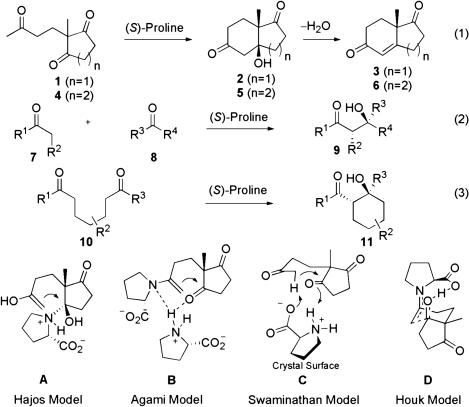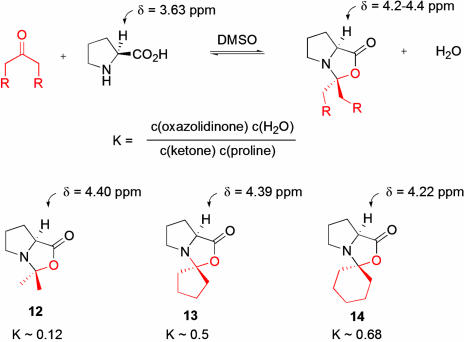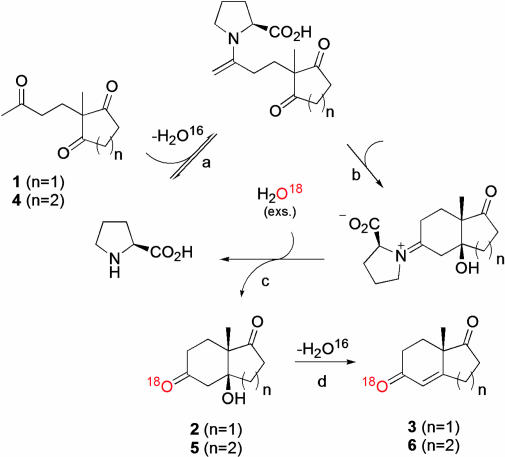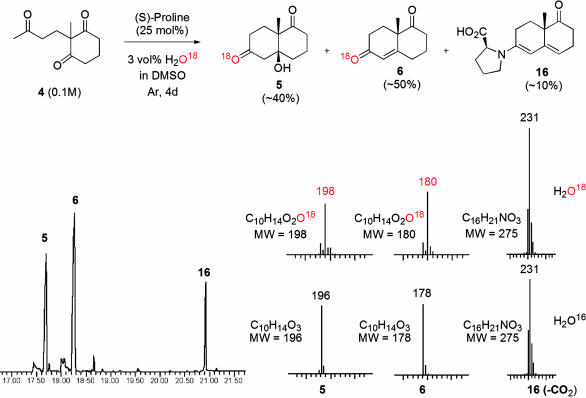Abstract
The mechanism of the proline-catalyzed aldol reaction has stimulated considerable debate, and despite limited experimental data, at least five different mechanisms have been proposed. Complementary to recent theoretical studies we have initiated an experimental program with the goal of clarifying some of the basic mechanistic questions concerning the proline-catalyzed aldol reaction. Here we summarize our discoveries in this area and provide further evidence for the involvement of enamine intermediates.
Discovered in the early 1970s, the Hajos–Parrish–Eder–Sauer–Wiechert reaction (1, 2), a proline-catalyzed intramolecular aldol reaction, represents not only the first asymmetric aldol reaction invented by chemists but also the first highly enantioselective organocatalytic transformation [1(4) → 2(5) → 3(6)] (Eq. 1 of Scheme 1) (3–6). Inspired by Nature's phenomenal enzymes, which catalyze direct asymmetric aldolizations of unmodified carbonyl compounds (7, 8), we have recently extended the Hajos–Parrish–Eder–Sauer–Wiechert reaction to the first intermolecular variant (7 + 8 → 9) (Eq. 2 of Scheme 1) (9), and to several other reactions including proline-catalyzed asymmetric Mannich (10), Michael (11), α-amination (12), and intramolecular enolexo aldolization reactions (10 → 11) (13) (Eq. 3 of Scheme 1) (14–18).
Scheme 1.
Proline-catalyzed aldolizations (Eqs. 1–3) and proposed mechanisms (transition states).
Similar to the aldolase enzymes, proline catalyzes direct asymmetric aldol reactions between two different carbonyl compounds to provide aldol products in excellent yields and enantioselectivities. Early on it has been speculated that in addition to operating on related substrates, both class I aldolases and proline may also share a similar enamine mechanism (19, 20). However, there has been some debate over several mechanistic aspects of the reaction, and a number of alternative models have been proposed. For example, Hajos (1) suggested a mechanism that involves the “activation” of one of the enantiotopic acceptor carbonyl groups as a carbinol amine (A of Scheme 1). At least the stereochemistry of this model was questioned by Jung (19) soon after its initial proposal. An enamine mechanism was suggested by various groups already in the 1970s and 1980s (19–21). Nonlinearity studies by Agami and colleagues (21) have led to the proposal of a side-chain enamine mechanism that involves two proline molecules in the C–C-bondforming transition state, one engaged in enamine formation and the other as a proton transfer mediator (B of Scheme 1). Swaminathan et al. (22) favor a heterogeneous aldolization mechanism on the surface of crystalline proline (C of Scheme 1), despite the fact that many proline-catalyzed aldolizations are completely homogenous. Agami's widely accepted two-proline mechanism was recently challenged when we proposed a homogenous one-proline enamine mechanism for the intermolecular variant in which the various proton transfers are mediated by proline's carboxylic acid functionality (9). On the basis of density functional theory calculations, Houk et al. (23–25) subsequently proposed a very similar mechanism for the intramolecular variant (D of Scheme 1). Surprisingly, despite the apparent interest, very limited experimental data in support of either of the several mechanistic proposals has been accumulated.
We have recently reported evidence for the involvement of only one proline molecule in the transition state of the C–C-bond forming step of both proline-catalyzed inter- and intramolecular aldol reactions (26). Here we build on these findings and provide evidence for enamine intermediates. We show that if the Hajos–Parrish–Eder–Sauer–Wiechert reaction is conducted in the presence of 18O-enriched water, the side-chain carbonyl group is indeed labeled, a requirement of the proposed enamine mechanism. In addition, covalent intermediates formed in reversible reactions of ketones with proline have been detected and characterized by 1H NMR, and equilibrium constants of their formation have been estimated.
Our studies on the mechanism of the proline-catalyzed aldol reaction began when we found that whereas Agami had demonstrated that the intramolecular Hajos–Parrish–Eder–Sauer–Wiechert reaction apparently showed a nonlinear effect in the asymmetric catalysis, our intermolecular variant did not. Additional evidence that only one proline molecule may be involved in the transition state of the intermolecular aldol variant came from kinetic studies. We determined retroaldolization kinetics of a fluorogenic substrate and found these to be first order in proline. Intrigued by the apparent mechanistic discrepancy between inter- and intramolecular proline catalyzed aldolizations, we set up experiments to confirm the nonlinear effects earlier reported for the intramolecular reaction. However, in this carefully conducted study no such effects could be observed. In addition, previously reported dilution effects on the enantioselectivity could not be reproduced. An explanation for the observed differences may be that Agami and colleagues (21) had used optical rotation measurement for the ee determinations, whereas we had used a more accurate HPLC-based assay. Another strong piece of evidence for our one-proline mechanism came from studies with polymer-supported proline as the catalyst for asymmetric inter- and intramolecular aldolizations and for our previously discovered asymmetric Mannich reaction (10, 27–29). It was shown that rates and enantioselectivities of the supported catalysts are comparable with proline itself. Because a two-proline mechanism on the polymer is unlikely, these studies as well as our own experiments effectively removed the remaining evidence for the previously widely accepted Agami mechanism and clearly supported the proposed one-proline mechanism. What remained to be shown was that the reaction indeed proceeds via enamine intermediates, because alternative noncovalent mechanisms or even the unusual Hajos mechanism could not be entirely ruled out.
Materials and Methods
NMR Study. For the preparation of a 2 mg/ml stock solution, dried (P4O10) and finely powdered proline was stirred in dry DMSO-d6 for 12 h under argon. Different 0.6-ml samples of this solution in an NMR tube were treated with varying amounts of the freshly dried and distilled ketone (acetone, cyclopentanone, and cyclohexanone). The concentrations of proline, ketone, oxazolidinone, and water were determined by integration of characteristic NMR signals, and equilibrium constants were determined accordingly at varying ketone concentrations.
GC-MS Study. A 0.2 M stock solution of dried triketone 4 (39.2 mg, 0.2 mmol) in dry DMSO (1 ml) was prepared under argon. Each 500 μl of this solution were successively treated with 470 μl of dry DMSO, 30 μl of water [regular or 18O-enriched (95%, Aldrich)], and dried (S)-proline (2.9 mg, 0.025 mmol, 25 mol %). The mixtures were stirred for 4 days under argon. Samples were submitted to GC-MS (Agilent Technologies, Palo Alto, CA).
Results and Discussion
Seebach Oxazolidinones Are Formed in Parasitic Equilibria Between Ketones and Proline. Although chiral enamines prepared from proline derivatives have been used in stoichiometric asymmetric synthesis (30), enamines of unactivated carbonyl compound derived from proline itself have never been isolated or characterized. In fact, although vinylogous amides or carbamates from proline and β-keto esters or β-diketones can be prepared efficiently, unactivated carbonyl compounds do not provide the corresponding enamines in easily detectable quantities, but provide alternative products instead. The reaction of proline with aldehydes has been studied already in the 1980s, and it was found that rather than enamines, oxazolidinones are formed reversibly from α-branched and -trisubstituted aldehydes (31). In a 1H NMR study, we found that in the proline-catalyzed reaction of acetone with isobutyraldehyde or pivaldehyde in d6-DMSO, proline is initially quantitatively engaged in oxazolidinone formation. Seebach had previously used these oxazolidinones in an elegant overall asymmetric α-alkylation reaction of proline (32). The formation of oxazolidinones in the proline-catalyzed intermolecular aldol reaction, however, can best be characterized in terms of a parasitic equilibrium that, whereas unwanted and rate-diminishing, would still allow for turnover. At the same time, rapid oxazolidinone formation is indicative for the ease of covalent interactions between proline and aldehydes. Carbinolamines, iminium ions, and enamines may also be formed in these reactions but at much lower concentrations. However, Seebach oxazolidinones or other covalent adducts have never been described before in the reaction of proline with unactivated ketones such as those typically used in proline-catalyzed aldolizations, e.g., acetone, cyclopentanone, or cyclohexanone.
Using 1H NMR, we found that under standard reaction conditions (1–20 vol % ketone donor/DMSO) but in the absence of aldehydes, proline indeed reacts with ketones to give the expected oxazolidinones along with 1 eq of water in a concentration-dependent, reversible manner. We estimated equilibrium constants at various ketone concentrations. For example, acetone gave oxazolidinone 12 with an observed estimated equilibrium constant of K = ≈0.12 (Scheme 2). Similarly, cyclopentanone and cyclohexanone underwent the same transformation under these conditions to furnish oxazolidinones 13 (K = ≈0.5) and 14 (K = ≈0.68), respectively. Thus, under standard conditions but in the absence of aldehyde, proline is almost quantitatively engaged in unproductive oxazolidinone formation with simple ketones. We have not been able to detect enamine or iminium ion intermediates under these conditions by 1H NMR. However, ketone self-aldolization or aldolization with added aldehyde proceeds over time. Thus, the observed oxazolidinone formation demonstrates that in addition to the reaction of aldehydes, the initial covalent reaction of ketones with proline is a facile process.
Scheme 2.
Seebach oxazolidinones are formed reversibly from simple ketones and (S)-proline.
18O-Incorporation Studies. Although we have so far been unable to detect proline enamines of simple aldehydes or ketones, we have obtained further indirect evidence for their formation in proline catalyzed aldolizations.
The typically used substrate concentration in the Hajos–Parrish–Eder–Sauer–Wiechert cyclization (0.1–0.5 M) is generally smaller compared to the ketone concentration used in the intermolecular reaction (2–4 M). From our estimated equilibrium constants only a small oxazolidinone concentration is expected to be formed under typical Hajos–Parrish–Eder–Sauer–Wiechert conditions. Indeed NMR spectra in this case hardly provide evidence for oxazolidinone formation and typically only show mixtures of starting material and product along with the proline catalyst.
However, an alternative way to prove a dehydrative covalent interaction between proline and the ketone substrate could involve an 18O-incorporation study. If the proposed enamine mechanism was indeed operative and the reaction were to be run in the presence of 18O-enriched water, incorporation of 18O at the initially acyclic carbonyl group would be expected because of the final hydrolysis step in the enamine catalysis cycle (Scheme 3).
Scheme 3.
The proposed enamine catalysis cycle of the Hajos–Parrish–Eder–Sauer–Wiechert reaction requires 18O incorporation when the reaction is performed in the presence of 18O-enriched water.
Surprisingly, Hajos had reported that in contrast to what would be expected from considering the enamine mechanism, 18O incorporation did not occur, although important details of these experiments have never been published (1).
We have studied the Hajos–Parrish–Eder–Sauer–Wiechert cyclization of ketones 1 and 4 to give the corresponding aldol addition (2 and 5) or condensation products (3 and 6) in the presence of 18O-enriched water (95% 18O, Aldrich), using carefully controlled conditions. When the reactions were performed under completely air- and moisture-free conditions (except of course for the purposely added water), and when both the substrate and proline catalyst had been carefully dried azeotropically, and when dried solvent (DMSO) was used, high 18O incorporation was indeed observed. Triketone 4 in the presence of proline (25 mol %) and 16O- or 18O-enriched water (3 vol %) gave after 4 days' reaction time ≈40% of the aldol addition product 5, ≈50% of the aldol condensation product 6, and ≈10% of dieneamine 16 as detected by GC (Scheme 4). If run in the presence of 16O water, the corresponding M+· at 196 (5), 178 (6), and 231 (16–CO2) can be identified. However, in the presence of 18O-enriched water, both the M+· of the aldol addition and aldol condensation products appear at two mass units higher at 198 (5) and 180 (6), respectively, clearly demonstrating efficient (> 90%) 18O incorporation. Because both products incorporate exactly one 18O atom, incorporation could not have occurred at the alcohol moiety. That dieneamine 16 did not incorporate 18O indicates that the site of incorporation of the single 18O oxygen atom must be at the carbonyl group expected from the proposed enamine mechanism. Similar results were obtained when triketone 1 was used as the substrate to give both 18O-labeled aldol 2 and traces of enone 3.
Scheme 4.
18O-incorporation experiment.
In summary, our studies provide further evidence for covalent catalysis in the proline-catalyzed aldol reaction. We show that initial covalent adduct formation between ketones and proline is a fast and facile reaction and that, in the presence of [18O]water, 18O labeling does indeed occur at the expected position. These studies, together with our previous experimental investigations and Houk's DFT calculation, may further help to bring light into the vast mechanistic darkness of what is believed to be enamine catalysis.
Acknowledgments
We thank the Departments of Mass Spectrometry and NMR Spectroscopy of The Scripps Research Institute (La Jolla, CA) for technical assistance, the Max-Planck-Institut für Kohlenforschung, and Dr. Sabine Behnsen for encouragement. This work was supported by National Institutes of Health Grant RO1 GM-63914 (to B.L.).
This paper was submitted directly (Track II) to the PNAS office.
References
- 1.Hajos, Z. G. & Parrish, D. R. (1974) J. Org. Chem. 39, 1615–1621. [Google Scholar]
- 2.Eder, U., Sauer, G. & Wiechert, R. (1971) Angew. Chem. Int. Ed. Engl. 10, 496–497. [Google Scholar]
- 3.Dalko, P. I. & Moisan, L. (2001) Angew. Chem. Int. Ed. Engl. 40, 3726–3748. [DOI] [PubMed] [Google Scholar]
- 4.Movassaghi, M. & Jacobsen, E. N. (2002) Science 298, 1904–1905. [DOI] [PubMed] [Google Scholar]
- 5.List, B. (2002) Tetrahedron 58, 5572–5590. [Google Scholar]
- 6.Jarvo, E. R. & Miller, S. J. (2002) Tetrahedron 58, 2481–2495. [Google Scholar]
- 7.Lai, C. Y., Nakai, N. & Chang, D. (1974) Science 183, 1204–1206. [DOI] [PubMed] [Google Scholar]
- 8.Barbas, C. F., III, Heine, A., Zhong, G., Hoffmann, T., Gramatikova, S., Björnestedt, R., List, B., Anderson, J., Stura, E. A., Wilson, I. A. & Lerner, R. A. (1997) Science 278, 2085–2092. [DOI] [PubMed] [Google Scholar]
- 9.List, B., Lerner, R. A. & Barbas, C. F., III (2000) J. Am. Chem. Soc. 122, 2395–2396. [Google Scholar]
- 10.List, B. (2000) J. Am. Chem. Soc. 122, 9336–9337. [Google Scholar]
- 11.List, B., Pojarliev, P. & Martin, H. J. (2001) Org. Lett. 3, 2423–2425. [DOI] [PubMed] [Google Scholar]
- 12.List, B. (2002) J. Am. Chem. Soc. 124, 5656–5657. [DOI] [PubMed] [Google Scholar]
- 13.Pidathala, C., Hoang, L., Vignola, N. & List, B. (2003) Angew. Chem. Int. Ed. Engl. 42, 2785–2788. [DOI] [PubMed] [Google Scholar]
- 14.Vignola, N. & List, B. (2004) J. Am. Chem. Soc. 126, 450–451. [DOI] [PubMed] [Google Scholar]
- 15.Northrup, A. B. & MacMillan, D. W. C. J. (2002) J. Am. Chem. Soc. 124, 6798–6799. [DOI] [PubMed] [Google Scholar]
- 16.Córdova, A., Notz, W. & Barbas, C. F., III (2002) J. Org. Chem. 67, 301–303. [DOI] [PubMed] [Google Scholar]
- 17.Bøgevig, A., Kumaragurubaran, N. & Jørgensen, K. A. (2002) Chem. Commun., 620–621. [DOI] [PubMed]
- 18.Saito, S., Nakadai, M. & Yamamoto, H. (2001) Synlett, 1245–1248.
- 19.Jung, M. E. (1976) Tetrahedron 32, 3–31. [Google Scholar]
- 20.Brown, K. L., Damm, L., Dunitz, J. D., Eschenmoser, A., Hobi, R. & Kratky, C. (1978) Helv. Chim. Acta 61, 3108–3135. [Google Scholar]
- 21.Puchot, C., Samuel, O., Dunach, E., Zhao, S., Agami, C. & Kagan, H. B. (1986) J. Am. Chem. Soc. 108, 2353–2357. [DOI] [PubMed] [Google Scholar]
- 22.Rajagopal, D., Moni, M. S., Subramanian, S. & Swaminathan, S. (1999) Tetrahedron Asymmetry 10, 1631–1634. [Google Scholar]
- 23.Bahmanyar, S. & Houk, K. N. (2001) J. Am. Chem. Soc. 123, 9922–9923.11583567 [Google Scholar]
- 24.Bahmanyar, S. & Houk, K. N. (2001) J. Am. Chem. Soc. 123, 11273–11283. [DOI] [PubMed] [Google Scholar]
- 25.Bahmanyar, S., Houk, K. N., Martin, H. J. & List, B. (2003) J. Am. Chem. Soc. 125, 2475–2479. [DOI] [PubMed] [Google Scholar]
- 26.Hoang, L., Bahmanyar, S., Houk, K. N. & List, B. (2003) J. Am. Chem. Soc. 125, 16–17. [DOI] [PubMed] [Google Scholar]
- 27.Kondo, K., Yamano, T. & Takemoto, K. (1985) Macromol. Chem. 186, 1781–1785. [Google Scholar]
- 28.Benaglia, M., Celentano, G. & Cozzi, F. (2001) Adv. Synth. Catal. 343, 171–175. [Google Scholar]
- 29.Benaglia, M., Cinquini, M., Cozzi, F. & Puglisi, A. (2002) Adv. Synth. Catal. 344, 533–540. [Google Scholar]
- 30.Yamada, S. & Otani, G. (1969) Tetrahedron Lett., 4237–4240.
- 31.Orsini, F., Pelizzoni, F., Forte, M., Jisti, M., Bombieri, G. & Benetollo, F. (1989) J. Heterocycl. Chem. 26, 837–841. [Google Scholar]
- 32.Jeebach, D., Boes, M., Naef, R. & Schweizer, W. B. (1983) J. Am. Chem. Soc. 105, 5390–5398. [Google Scholar]






